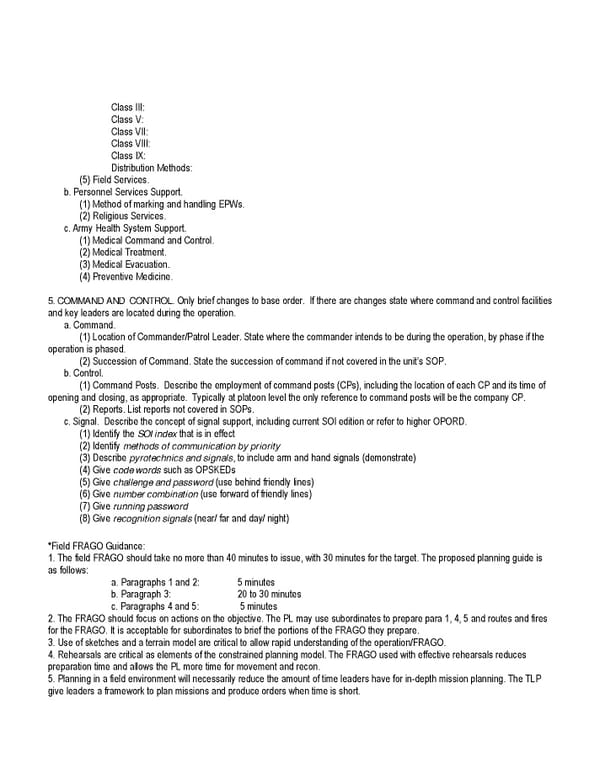Class III: Class V: Class VII: Class VIII: Class IX: Distribution Methods: (5) Field Services. b. Personnel Services Support. (1) Method of marking and handling EPWs. (2) Religious Services. c. Army Health System Support. (1) Medical Command and Control. (2) Medical Treatment. (3) Medical Evacuation. (4) Preventive Medicine. 5. COMMAND AND CONTROL. Only brief changes to base order. If there are changes state where command and control facilities and key leaders are located during the operation. a. Command. (1) Location of Commander/Patrol Leader. State where the commander intends to be during the operation, by phase if the operation is phased. (2) Succession of Command. State the succession of command if not covered in the unit’s SOP. b. Control. (1) Command Posts. Describe the employment of command posts (CPs), including the location of each CP and its time of opening and closing, as appropriate. Typically at platoon level the only reference to command posts will be the company CP. (2) Reports. List reports not covered in SOPs. c. Signal. Describe the concept of signal support, including current SOI edition or refer to higher OPORD. (1) Identify the SOI index that is in effect (2) Identify methods of communication by priority (3) Describe pyrotechnics and signals, to include arm and hand signals (demonstrate) (4) Give code words such as OPSKEDs (5) Give challenge and password (use behind friendly lines) (6) Give number combination (use forward of friendly lines) (7) Give running password (8) Give recognition signals (near/ far and day/ night) *Field FRAGO Guidance: 1. The field FRAGO should take no more than 40 minutes to issue, with 30 minutes for the target. The proposed planning guide is as follows: a. Paragraphs 1 and 2: 5 minutes b. Paragraph 3: 20 to 30 minutes c. Paragraphs 4 and 5: 5 minutes 2. The FRAGO should focus on actions on the objective. The PL may use subordinates to prepare para 1, 4, 5 and routes and fires for the FRAGO. It is acceptable for subordinates to brief the portions of the FRAGO they prepare. 3. Use of sketches and a terrain model are critical to allow rapid understanding of the operation/FRAGO. 4. Rehearsals are critical as elements of the constrained planning model. The FRAGO used with effective rehearsals reduces preparation time and allows the PL more time for movement and recon. 5. Planning in a field environment will necessarily reduce the amount of time leaders have for in-depth mission planning. The TLP give leaders a framework to plan missions and produce orders when time is short.
 Ranger Handbook Page 37 Page 39
Ranger Handbook Page 37 Page 39